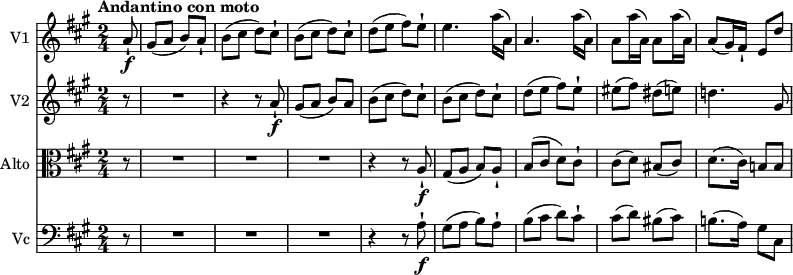Symphonie no 30 de Mozart
La Symphonie no 30 en ré majeur KV 202/186b[1] est une symphonie du compositeur autrichien Wolfgang Amadeus Mozart, achevée le à Salzbourg, alors que le compositeur était âgé de dix-huit ans.
| Symphonie no 30 en ré majeur KV 202/186b | |
 Mozart en 1777. | |
| Genre | Symphonie |
|---|---|
| Nb. de mouvements | 4 |
| Musique | Wolfgang Amadeus Mozart |
| Effectif | Orchestre symphonique |
| Durée approximative | environ 22 minutes |
| Dates de composition | à Salzbourg |
| Partition autographe | Autographe dans une collection privée à Vienne. |
| Création | inconnue |
Historique
La première édition a été faite à titre posthume chez Günther und Böhme à Hambourg en 1799.
Instrumentation
| Instrumentation de la symphonie no 30 |
| Cordes |
|---|
| premiers violons, seconds violons, altos, violoncelles, contrebasses |
| Bois |
| 2 hautbois |
| Cuivres |
| 2 cors en ré, 2 trompettes en ré |
Les orchestres contemporains ajoutent parfois des bassons et des timbales.
Structure
La symphonie comprend quatre mouvements :
- Molto allegro, à

 , en ré majeur, 207 mesures
, en ré majeur, 207 mesures - Andantino con moto, à

 , en la majeur, 74 mesures, cordes seules
, en la majeur, 74 mesures, cordes seules - Menuetto et Trio, à

 , en ré majeur, trio en sol majeur, 40+20 mesures
, en ré majeur, trio en sol majeur, 40+20 mesures - Presto, à

 , en ré majeur, 219 mesures
, en ré majeur, 219 mesures
Durée : environ 22 minutes
Introduction du Molto allegro :
Introduction de l'Andantino con moto :
Première reprise du Menuetto :
Première reprise du Trio :
Introduction du Presto :
Références
- La symphonie porte le numéro 186b dans la sixième édition du Catalogue Köchel.
Liens externes
- Ressources relatives à la musique :
Bibliographie
- François-René Tranchefort (direction), Guide de la Musique Symphonique, Paris, Fayard, coll. « Les indispensables de la musique », (1re éd. 1986), 896 p. (ISBN 2-213-01638-0), p. 511
- Bertrand Dermoncourt (direction), Tout Mozart : Encyclopédie de A à Z, Paris, Robert Laffont, coll. « Bouquins », , 1093 p. (ISBN 2-221-10669-5), p. 943
Cet article est issu de wikipedia. Text licence: CC BY-SA 4.0, Des conditions supplémentaires peuvent s’appliquer aux fichiers multimédias.




